check engine MITSUBISHI GRANDIS 2008 (in English) User Guide
[x] Cancel search | Manufacturer: MITSUBISHI, Model Year: 2008, Model line: GRANDIS, Model: MITSUBISHI GRANDIS 2008Pages: 458, PDF Size: 18.52 MB
Page 174 of 458

4-2 Starting and driving
4Economical driving
E00600100372
For economical driving, there are some technical requirements
that have to be met. The prerequisite for low fuel consumption
is a properly adjusted engine. In order to achieve longer life of
the vehicle and the most economical operation, we recommend
you have the vehicle checked at regular intervals in accordance
with the service standards.
Fuel economy and generation of exhaust gas and noise are
highly influenced by personal driving habits as well as the par-
ticular operating conditions. The following points should be
observed in order to minimize wear of brakes, tyres and engine
as well as to reduce environmental pollution.StartingAvoid rapid acceleration and sudden starts; such operation will
result in higher fuel consumption.ShiftingShift only at an appropriate speed and engine speed. Always
use the highest gear possible.City trafficFrequent starting and stopping increases the average fuel con-
sumption. Use roads with smooth traffic flow whenever possi-
ble. When driving on congested roads, avoid use of a low gear
at high engine speeds.IdlingThe vehicle consumes fuel even during idling. Avoid extended
idling whenever possible.
SpeedThe higher the vehicle speed, the more fuel consumed. Avoid
driving at full speed. Even a slight release of the accelerator
pedal will save a significant amount of fuel.Tyre inflation pressureCheck the tyre inflation pressures at regular intervals. Low tyre
inflation pressure increases road resistance and fuel consump-
tion. In addition, low tyre pressures adversely affect tyre wear
and driving stability.LoadDo not drive with unnecessary articles in the luggage compart-
ment. Especially during city driving where frequent starting
and stopping is necessary, the increased weight of the vehicle
will greatly affect fuel consumption. Also avoid driving with
unnecessary luggage, etc., on the roof; the increased air resist-
ance will increase fuel consumption.Cold engine startingStarting of a cold engine consumes more fuel.
Unnecessary fuel consumption is also caused by keeping a hot
engine running. After the engine is started, commence driving
as soon as possible.Air conditioningThe use of the air conditioning will increase the fuel consump-
tion.
BK-XP08E1ENUK.en-uk.book Page 2 Monday, August 13, 2007 2:20 PM
Page 180 of 458
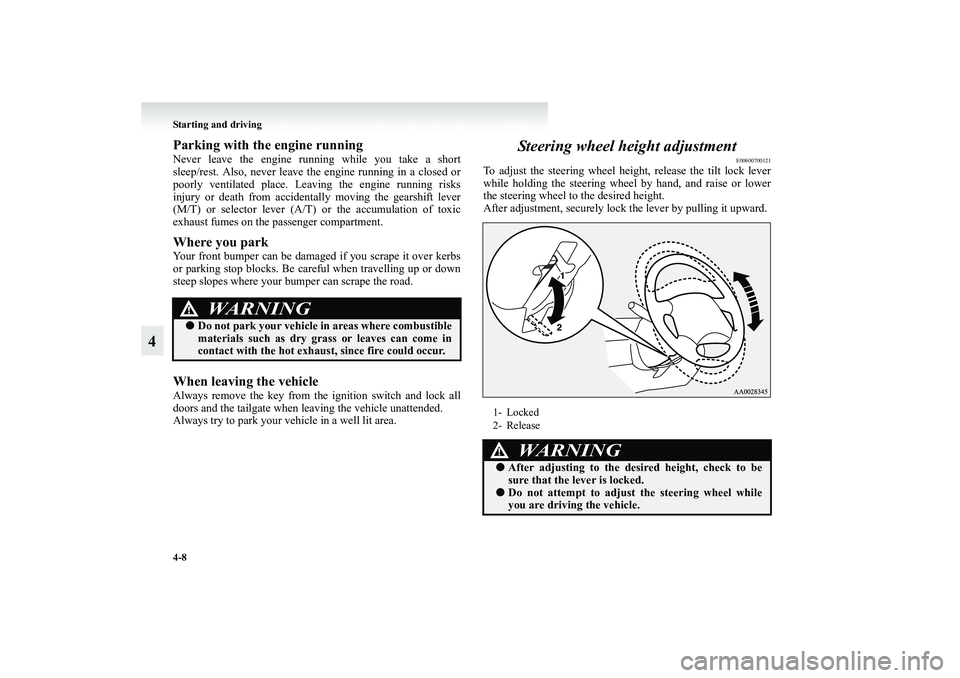
4-8 Starting and driving
4
Parking with the engine runningNever leave the engine running while you take a short
sleep/rest. Also, never leave the engine running in a closed or
poorly ventilated place. Leaving the engine running risks
injury or death from accidentally moving the gearshift lever
(M/T) or selector lever (A/T) or the accumulation of toxic
exhaust fumes on the passenger compartment.Where you parkYour front bumper can be damaged if you scrape it over kerbs
or parking stop blocks. Be careful when travelling up or down
steep slopes where your bumper can scrape the road.When leaving the vehicleAlways remove the key from the ignition switch and lock all
doors and the tailgate when leaving the vehicle unattended.
Always try to park your vehicle in a well lit area.
Steering wheel height adjustment
E00600700121
To adjust the steering wheel height, release the tilt lock lever
while holding the steering wheel by hand, and raise or lower
the steering wheel to the desired height.
After adjustment, securely lock the lever by pulling it upward.
WARNING
!●Do not park your vehicle in areas where combustible
materials such as dry grass or leaves can come in
contact with the hot exhaust, since fire could occur.
1- Locked
2- Release
WARNING
!●After adjusting to the desired height, check to be
sure that the lever is locked.●Do not attempt to adjust the steering wheel while
you are driving the vehicle.
BK-XP08E1ENUK.en-uk.book Page 8 Monday, August 13, 2007 2:20 PM
Page 193 of 458

Starting and driving
4-21
4
NOTE●If the engine is cold, the diesel preheat indication lamp is
on for a longer time.
●When the engine has not been started within about 5 sec-
onds after the diesel preheat indication lamp went out,
return the ignition key to the “LOCK” position. Then, turn
the key to the “ON” position to preheat the engine again.
●When the engine is warm, the diesel preheat indication
lamp does not come on even if the ignition key is placed
in the “ON” position.
Start the engine by turning the ignition key right to the
“START” position.
7. Turn the ignition key to the “START” position without
depressing the accelerator pedal, and release it when the
engine starts.NOTE●A ticking noise may be heard after starting the engine.
This is not an abnormal condition. The noise will disap-
pear after a short time of engine running.
If the ticking noise continues after the engine is warmed
up, we recommend you to have your vehicle checked.
Diesel particulate filter (DPF)
*
E00619800069
The diesel particulate filter (DPF) is a device that captures
most of the particulate matter (PM) in the exhaust emissions of
the diesel engine. The DPF automatically burns away trapped
PM during vehicle operation. Under certain driving conditions,
however, the DPF is not able to burn away all of the trapped
PM and, as a result, an excessive amount of PM accumulates
inside.NOTE●To minimize the likelihood of excessive accumulation of
PM, try to avoid driving for long periods at low speeds
and repeatedly driving short distances.
WARNING
!●The DPF reaches very high temperatures. Do not
park your vehicle in areas where combustible mate-
rials such as dry grass or leaves can come in contact
with the hot exhaust system since fire could occur.
CAUTION
!●Do not use any type of fuel or engine oil that is not
specified for your vehicle. Also, do not use any mois-
ture-removing agent or other fuel additive. Such
substances could have a detrimental effect on the
DPF.
Refer to “Fuel selection” on page 2 and “Engine oil”
on page 8-7.
BK-XP08E1ENUK.en-uk.book Page 21 Monday, August 13, 2007 2:20 PM
Page 194 of 458
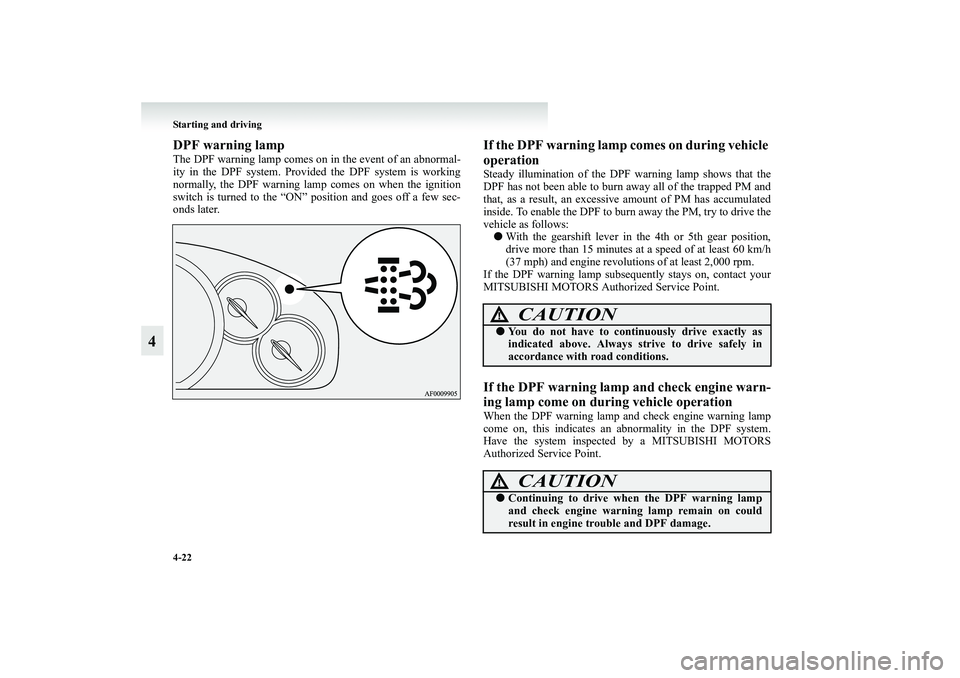
4-22 Starting and driving
4
DPF warning lampThe DPF warning lamp comes on in the event of an abnormal-
ity in the DPF system. Provided the DPF system is working
normally, the DPF warning lamp comes on when the ignition
switch is turned to the “ON” position and goes off a few sec-
onds later.
If the DPF warning lamp comes on during vehicle
operationSteady illumination of the DPF warning lamp shows that the
DPF has not been able to burn away all of the trapped PM and
that, as a result, an excessive amount of PM has accumulated
inside. To enable the DPF to burn away the PM, try to drive the
vehicle as follows:
●With the gearshift lever in the 4th or 5th gear position,
drive more than 15 minutes at a speed of at least 60 km/h
(37 mph) and engine revolutions of at least 2,000 rpm.
If the DPF warning lamp subsequently stays on, contact your
MITSUBISHI MOTORS Authorized Service Point.If the DPF warning lamp and check engine warn-
ing lamp come on during vehicle operationWhen the DPF warning lamp and check engine warning lamp
come on, this indicates an abnormality in the DPF system.
Have the system inspected by a MITSUBISHI MOTORS
Authorized Service Point.
CAUTION
!●You do not have to continuously drive exactly as
indicated above. Always strive to drive safely in
accordance with road conditions.
CAUTION
!●Continuing to drive when the DPF warning lamp
and check engine warning lamp remain on could
result in engine trouble and DPF damage.
BK-XP08E1ENUK.en-uk.book Page 22 Monday, August 13, 2007 2:20 PM
Page 206 of 458

4-34 Starting and driving
4
Parking
E00604700233
To park the vehicle, first bring it to a complete stop, fully
engage the parking brake, and then move the selector lever to
the “P” (PARK) position.
If you are going to leave the vehicle unattended, always switch
off the engine and remove the ignition key.NOTE●On a slope, be sure to apply the parking brake before
moving the selector lever to the “P” (PARK) position. If
you move the selector lever to the “P” (PARK) position
before applying the parking brake, it may be difficult to
disengage the selector lever from the “P” (PARK) position
when next you drive the vehicle, requiring application of a
strong force to the selector lever to move from the “P”
(PARK) position.
When the A/T makes no speed change
E00604800351
If the transmission does not change speeds while driving, or
your vehicle does not pick up enough speed when starting on
an uphill slope, it may be that there is something unusual hap-
pening in the transmission, causing a safety device to activate.
We recommend you to have your vehicle checked as soon as
possible.
1. If your vehicle has difficulty moving uphill, shift the
selector lever into 2nd gear of the sports mode.
This method might not work depending on the type of
transmission malfunction.
2. Once the vehicle is moving on a level road, move the
selector lever back to “D” (DRIVE).NOTE●When the “N” indication lamp in the instrument panel
blinks, it means that there is an abnormal condition in the
transmission. Refer to “Selector lever position indication
lamps/“N” indication lamp” on page 4-28.
BK-XP08E1ENUK.en-uk.book Page 34 Monday, August 13, 2007 2:20 PM
Page 207 of 458
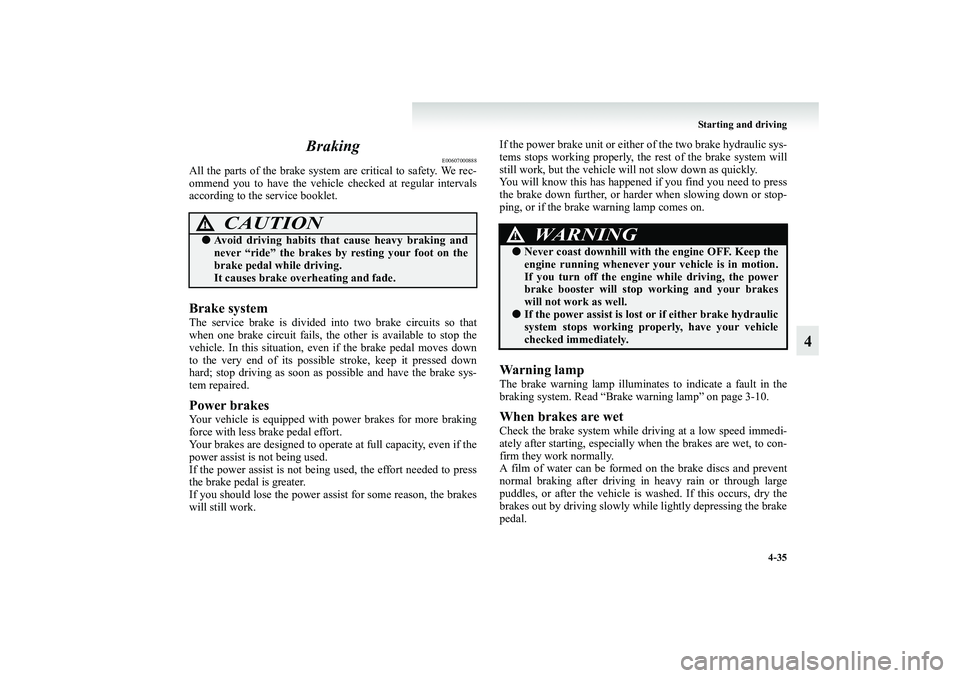
Starting and driving
4-35
4 Braking
E00607000888
All the parts of the brake system are critical to safety. We rec-
ommend you to have the vehicle checked at regular intervals
according to the service booklet.Brake systemThe service brake is divided into two brake circuits so that
when one brake circuit fails, the other is available to stop the
vehicle. In this situation, even if the brake pedal moves down
to the very end of its possible stroke, keep it pressed down
hard; stop driving as soon as possible and have the brake sys-
tem repaired.Power brakesYour vehicle is equipped with power brakes for more braking
force with less brake pedal effort.
Your brakes are designed to operate at full capacity, even if the
power assist is not being used.
If the power assist is not being used, the effort needed to press
the brake pedal is greater.
If you should lose the power assist for some reason, the brakes
will still work.If the power brake unit or either of the two brake hydraulic sys-
tems stops working properly, the rest of the brake system will
still work, but the vehicle will not slow down as quickly.
You will know this has happened if you find you need to press
the brake down further, or harder when slowing down or stop-
ping, or if the brake warning lamp comes on.
Wa r n i n g l a m pThe brake warning lamp illuminates to indicate a fault in the
braking system. Read “Brake warning lamp” on page 3-10.When brakes are wetCheck the brake system while driving at a low speed immedi-
ately after starting, especially when the brakes are wet, to con-
firm they work normally.
A film of water can be formed on the brake discs and prevent
normal braking after driving in heavy rain or through large
puddles, or after the vehicle is washed. If this occurs, dry the
brakes out by driving slowly while lightly depressing the brake
pedal.
CAUTION
!●Avoid driving habits that cause heavy braking and
never “ride” the brakes by resting your foot on the
brake pedal while driving.
It causes brake overheating and fade.
WARNING
!●Never coast downhill with the engine OFF. Keep the
engine running whenever your vehicle is in motion.
If you turn off the engine while driving, the power
brake booster will stop working and your brakes
will not work as well.●If the power assist is lost or if either brake hydraulic
system stops working properly, have your vehicle
checked immediately.
BK-XP08E1ENUK.en-uk.book Page 35 Monday, August 13, 2007 2:20 PM
Page 210 of 458
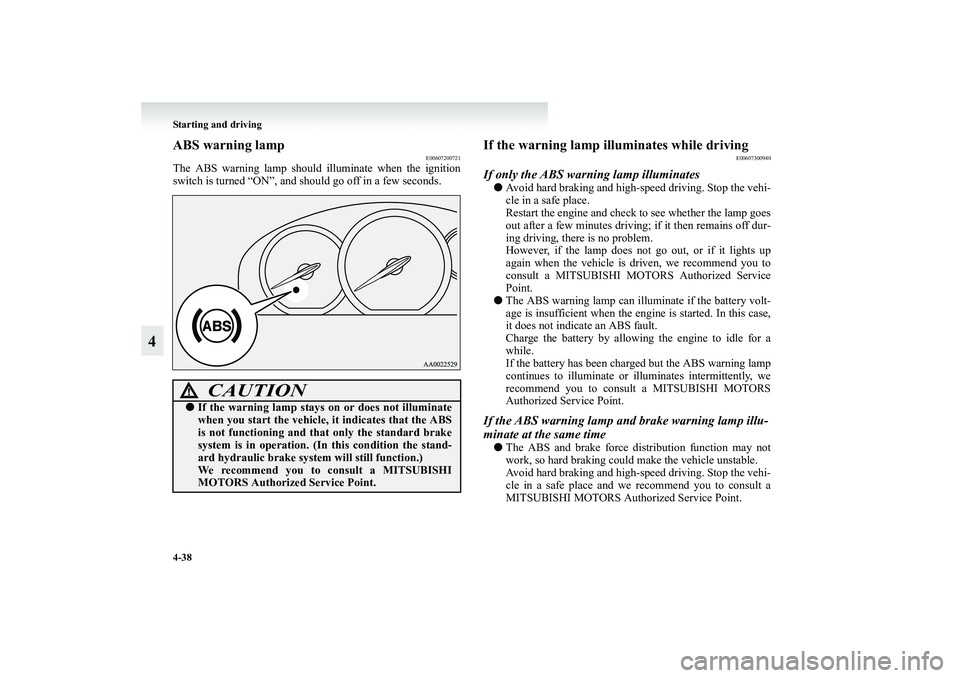
4-38 Starting and driving
4
ABS warning lamp
E00607200721
The ABS warning lamp should illuminate when the ignition
switch is turned “ON”, and should go off in a few seconds.
If the warning lamp illuminates while driving
E00607300940
If only the ABS warning lamp illuminates●Avoid hard braking and high-speed driving. Stop the vehi-
cle in a safe place.
Restart the engine and check to see whether the lamp goes
out after a few minutes driving; if it then remains off dur-
ing driving, there is no problem.
However, if the lamp does not go out, or if it lights up
again when the vehicle is driven, we recommend you to
consult a MITSUBISHI MOTORS Authorized Service
Point.
●The ABS warning lamp can illuminate if the battery volt-
age is insufficient when the engine is started. In this case,
it does not indicate an ABS fault.
Charge the battery by allowing the engine to idle for a
while.
If the battery has been charged but the ABS warning lamp
continues to illuminate or illuminates intermittently, we
recommend you to consult a MITSUBISHI MOTORS
Authorized Service Point.If the ABS warning lamp and brake warning lamp illu-
minate at the same time●The ABS and brake force distribution function may not
work, so hard braking could make the vehicle unstable.
Avoid hard braking and high-speed driving. Stop the vehi-
cle in a safe place and we recommend you to consult a
MITSUBISHI MOTORS Authorized Service Point.
CAUTION
!●If the warning lamp stays on or does not illuminate
when you start the vehicle, it indicates that the ABS
is not functioning and that only the standard brake
system is in operation. (In this condition the stand-
ard hydraulic brake system will still function.)
We recommend you to consult a MITSUBISHI
MOTORS Authorized Service Point.
BK-XP08E1ENUK.en-uk.book Page 38 Monday, August 13, 2007 2:20 PM
Page 212 of 458

4-40 Starting and driving
4
●The ABS becomes operative after the vehicle has acceler-
ated to a speed in excess of approximately 10 km/h
(6 mph). It stops operating when the vehicle decelerates to
a speed below approximately 5 km/h (3 mph).
Power steering system
E00607400127
When the engine is stopped, the power steering system will not
function and it will require greater manual effort to operate the
steering wheel. Keep this in mind in particular when towing the
vehicle. Never turn off the engine while driving.
Periodically check the power steering fluid level.
CAUTION
!●Do not hold the steering wheel in the fully turned
position (either left or right), for longer than 10 sec-
onds.
This can cause damage to the power steering system.
BK-XP08E1ENUK.en-uk.book Page 40 Monday, August 13, 2007 2:20 PM
Page 213 of 458
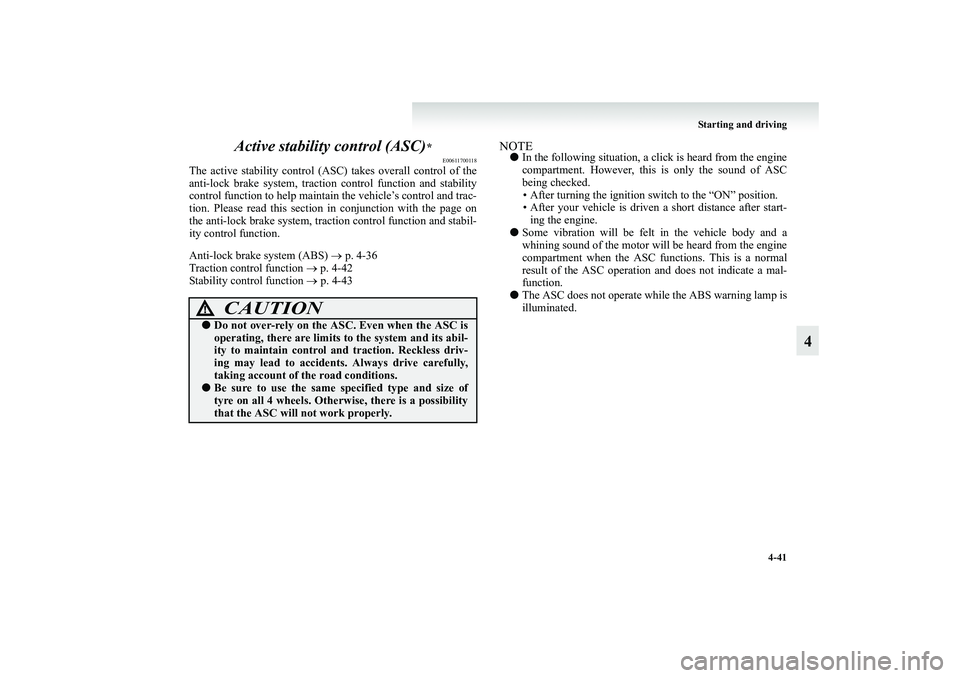
Starting and driving
4-41
4 Active stability control (ASC)
* E00611700118
The active stability control (ASC) takes overall control of the
anti-lock brake system, traction control function and stability
control function to help maintain the vehicle’s control and trac-
tion. Please read this section in conjunction with the page on
the anti-lock brake system, traction control function and stabil-
ity control function.
Anti-lock brake system (ABS) → p. 4-36
Traction control function → p. 4-42
Stability control function → p. 4-43
NOTE●In the following situation, a click is heard from the engine
compartment. However, this is only the sound of ASC
being checked.
• After turning the ignition switch to the “ON” position.
• After your vehicle is driven a short distance after start-
ing the engine.
●Some vibration will be felt in the vehicle body and a
whining sound of the motor will be heard from the engine
compartment when the ASC functions. This is a normal
result of the ASC operation and does not indicate a mal-
function.
●The ASC does not operate while the ABS warning lamp is
illuminated.
CAUTION
!●Do not over-rely on the ASC. Even when the ASC is
operating, there are limits to the system and its abil-
ity to maintain control and traction. Reckless driv-
ing may lead to accidents. Always drive carefully,
taking account of the road conditions.●Be sure to use the same specified type and size of
tyre on all 4 wheels. Otherwise, there is a possibility
that the ASC will not work properly.
BK-XP08E1ENUK.en-uk.book Page 41 Monday, August 13, 2007 2:20 PM
Page 216 of 458
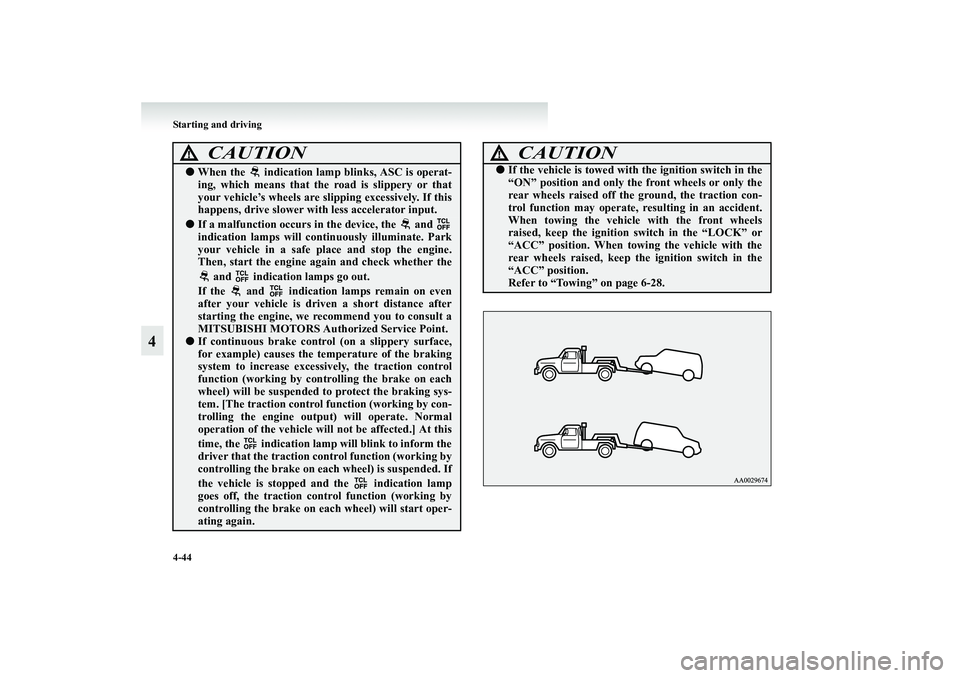
4-44 Starting and driving
4
CAUTION
!●When the indication lamp blinks, ASC is operat-
ing, which means that the road is slippery or that
your vehicle’s wheels are slipping excessively. If this
happens, drive slower with less accelerator input.●If a malfunction occurs in the device, the and
indication lamps will continuously illuminate. Park
your vehicle in a safe place and stop the engine.
Then, start the engine again and check whether the
and indication lamps go out.
If the and indication lamps remain on even
after your vehicle is driven a short distance after
starting the engine, we recommend you to consult a
MITSUBISHI MOTORS Authorized Service Point.●If continuous brake control (on a slippery surface,
for example) causes the temperature of the braking
system to increase excessively, the traction control
function (working by controlling the brake on each
wheel) will be suspended to protect the braking sys-
tem. [The traction control function (working by con-
trolling the engine output) will operate. Normal
operation of the vehicle will not be affected.] At this
time, the indication lamp will blink to inform the
driver that the traction control function (working by
controlling the brake on each wheel) is suspended. If
the vehicle is stopped and the indication lamp
goes off, the traction control function (working by
controlling the brake on each wheel) will start oper-
ating again.
CAUTION
!●If the vehicle is towed with the ignition switch in the
“ON” position and only the front wheels or only the
rear wheels raised off the ground, the traction con-
trol function may operate, resulting in an accident.
When towing the vehicle with the front wheels
raised, keep the ignition switch in the “LOCK” or
“ACC” position. When towing the vehicle with the
rear wheels raised, keep the ignition switch in the
“ACC” position.
Refer to “Towing” on page 6-28.
BK-XP08E1ENUK.en-uk.book Page 44 Monday, August 13, 2007 2:20 PM